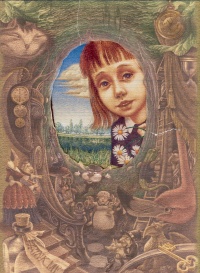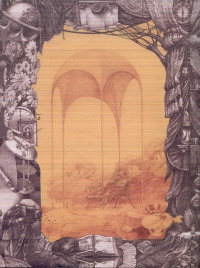| ________________
CM . . .
. Volume XVI Number 27. . . .March 19, 2010 
 |
Alice's Adventures in Wonderland.
Lewis Carroll. Illustrated by Oleg Lipchenko.
Toronto, ON: Tundra Books, 2009.
94 pp., hardcover, $24.99.
ISBN 978-0-88776-932-0.
Grades 3 and up / Ages 8 and up.
Review by Valerie Nielsen.
**** /4
|
| |
|

excerpt:
"…and what is the use of a book," thought Alice, "without pictures or conversations?"
A hundred and fifty-five years after the original publication of Lewis Carroll's Alice's Adventures in Wonderland in 1865, Tundra Books has published a new edition, one illustrated by noted painter Oleg Lipchenko, a member of Ukrainian Union of artists based in Toronto. While the conversations in Carroll's unabridged classic are the same—
"Take some more tea," the March Hare said to Alice, very earnestly.
"I've had nothing yet," Alice replied in an offended tone, "so I can't take more."
"You mean you can't take less," said the Hatter: "it's very easy to take more than nothing."
 —the pictures are very different. Lipchenko's style of drawing, executed in brown color filled in with ochre watercolour, is bound to produce something of an artistic shock to those readers brought up on Tenniel's carefully constructed, classical black and white depictions of Alice and the peculiar characters inhabiting her dream world. —the pictures are very different. Lipchenko's style of drawing, executed in brown color filled in with ochre watercolour, is bound to produce something of an artistic shock to those readers brought up on Tenniel's carefully constructed, classical black and white depictions of Alice and the peculiar characters inhabiting her dream world.
Lipchenko's words on the subject of his illustrations are both important and illuminating to those who are encountering this new edition of the children's classic. He says of his work:
This book is an Art project—not just another Alice. Every aspect of creation of this book is Art, from the visualization of the story's world, filled with strange yellowish atmosphere, until the finalized physical appearance of the book, which is the Art of Printing.
In an excerpt from a presentation entitled "Drawing Treacle Well or how to illustrate Alice" made to the Lewis Carroll Society of North America (which, by the way, has given the artist's fresh vision of Alice its solid approval) Lipchenko says that he began working on illustrating Alice many years ago when his daughter was very young, using black and white drawings done in pen and ink. He stopped working on these drawings after he was advised by friends that they were too dark and unsuitable for a children's book. Changing his technique to one he felt would appeal more to a young audience, he began making sketches using coloured pencils based on his reading of Alice in a Russian translation. When he eventually began to read (and re-read) Alice's Adventures in Wonderland in English, he discovered various perspectives which changed his view of Alice significantly enough for him to put aside the work for several years.
Of his final series of drawings, those that appear in the book, the artist speaks of the style of the pages themselves or the style of the layout of these pages as being of primary importance. Because of the theatrical side of the story, as well as its rich literary context, Lipchenko has divided the layout of the pages into three parts, each different in color and content. The brown and ochre watercolors of the main images are meant to create the feeling of the sepia tones of old photographs. The black and white images that surround the brown illustrations function as the scene's generic decoration; a sort of curtain or frame in which everything that takes place in the scene (including dialogue) is set apart. The third aspect of the all-important layout, according to the artist, is the text, the body of which is shaped so that it will flow with the borders of the black and white drawings.
Lipchenko says that one of the difficult issues he had to deal with was the depiction of Alice herself. Although the story is told from her point of view, and there is much information about her character, there is virtually none about her appearance. Lipchenko's depiction of Alice is as unlike Tenniel's as it could be (apart from her patent leather Mary-Jane shoes). Far from a proper Victorian dress, stiff bearing and long headband-controlled hair, the 2009 Alice has untidy fringed hair, a plain white-collared dress and a decidedly mischievous set of expressions. The characters inhabiting Wonderland bear resemblance neither to Tenniel's nor to the Disneyfied versions thereof with which modern children have been brought up.
There is much to enjoy and pore over in this brand new edition of Alice's Adventures in Wonderland.
Highly Recommended.
Valerie Nielsen, a retired teacher-librarian, lives in Winnipeg, MB.

To comment
on this title or this review, send mail to cm@umanitoba.ca.
Copyright © the Manitoba Library Association. Reproduction for personal
use is permitted only if this copyright notice is maintained. Any
other reproduction is prohibited without permission.
NEXT REVIEW |
TABLE OF CONTENTS FOR THIS ISSUE
- March 19, 2010.
AUTHORS |
TITLES |
MEDIA REVIEWS |
PROFILES |
BACK ISSUES |
SEARCH |
CMARCHIVE |
HOME |

 —the pictures are very different. Lipchenko's style of drawing, executed in brown color filled in with ochre watercolour, is bound to produce something of an artistic shock to those readers brought up on Tenniel's carefully constructed, classical black and white depictions of Alice and the peculiar characters inhabiting her dream world.
—the pictures are very different. Lipchenko's style of drawing, executed in brown color filled in with ochre watercolour, is bound to produce something of an artistic shock to those readers brought up on Tenniel's carefully constructed, classical black and white depictions of Alice and the peculiar characters inhabiting her dream world.